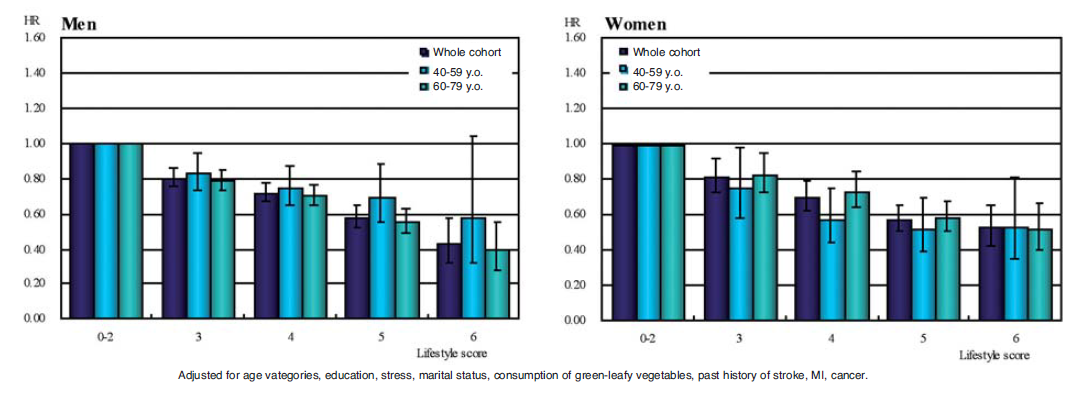Despite the established relationship between mortality and modifiable lifestyle risk factors, such as smoking, excessive drinking, obesity, and physical activity, it remains a difficult task to reduce the total number of deaths from these causes. From a public health perspective, a simple lifestyle assessment may be more feasible and can be readily applied to motivate the public to make lifestyle modifications.
We chose six healthy lifestyle factors (not currently smoking, not heavily drinking, walking one hour or more per day, sleeping 6.5 to 7.4 hours per day, eating green-leafy vegetables almost daily and BMI between 18.5 to 24.9) to examine the relationship with all-cause mortality. One point was credited for each of the healthy factors and points were totaled up to yield an overall lifestyle score ranging from zero to six points, with a higher score indicating a more favorable health-promoting lifestyle. Study subjects were those who participated in the Japanese Collaborative Cohort Study (JACC Study). There were more than 62,000 subjects included in the study, and the average follow-up period was 12.5 years.
Those with more healthy factors showed lower mortality risk
There was an inverse association between a baseline combination of six healthy lifestyle factors and the risk of all-cause mortality. Mortality risk for the highest group (score of six) was 0.43 among men and 0.53 among women, respectively, compared with the lowest group (score of 0-2). Even in the 60-79 year group, healthy lifestyles were associated with a significantly decreased risk of mortality.
Improved lifestyles could avoid 25% of deaths among men and 19% of deaths among women
The estimation showed that if all subjects would have altered all their six lifestyle factors to healthy categories, 49.4% of deaths among men and 29.8% of deaths among women could be avoided. Moreover, if all but the subjects with score six would have achieved a one-point increment in their lifestyle scores, it was estimated that 24.7% death among men and 18.5% death among women could be prevented.
About the healthy lifestyle score
The selection of lifestyle factors (smoking, drinking, walking, sleeping, green-leafy vegetable intake and weight status) were based on the reviews of many epidemiological studies. These factors were key elements of recent health promotions initiated by many Governments. Dichotomous criteria within these lifestyle factors were improved from the standpoint of modifiability, i.e., a person in an unhealthy group could change his or her behavior to a healthy group if so motivated; thus, quitting smoking or drinking was categorized as healthy status. As a result, the healthy lifestyle score we adopted was simple, understandable, easy to calculate without any sort of clinical test, and corresponded to lifestyle improvement. It may serve to motivate both individual and health promoters.
Conclusion
Our study indicated that baseline healthy lifestyle combination was associated with a linear decrease in the risk of all-cause mortality among both men and women, as well as among both the middle-aged and elderly. Moreover, if subjects manage to improve their lifestyle by even just one variable, 24.7% of deaths among men and 18.5% among women can be prevented. Such knowledge should prove useful to anyone who considers improving his or her lifestyle as well as to health promoters who plan population-based strategy in health improvement campaigns.

References
Tamakoshi A, Tamakoshi K, Lin Y, Yagyu K, Kikuchi S; JACC Study Group. Prev Med. 2009 May;48(5):486-92. Epub 2009 Feb 27
